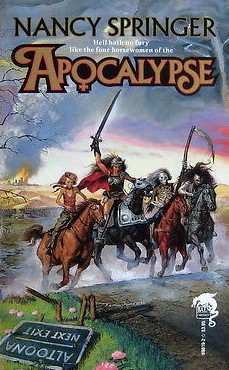 By NANCY SPRINGER (Baen Books; 1989)
By NANCY SPRINGER (Baen Books; 1989)
An early novel by the popular fantasist Nancy Springer that reads like a more fanciful WITCHES OF EASTWICK. It’s pretty good, too, with many pleasingly imaginative touches and an enjoyable feminist-minded narrative packed with a goodly amount of death, destruction and scary monsters.
It’s pretty good, too, with many pleasingly imaginative touches and an enjoyable feminist-minded narrative packed with a goodly amount of death, destruction and scary monsters.
It centers on Cally, whose real name is Apocalypse, a moniker that turns out to be quite prophetic in many respects. She lives in the Pennsylvania community of Hoadley, a depressed mining town where male-female relations are stuck in the eighteenth century. Things are shaken up by Joan, a frog-faced outcast who uses witchcraft to improve her looks and social standing. This leads to a rash of nightmarish visions, cicadas with human  heads and appearances by a seductive nude man who inexplicably resembles Barry, a Hoadley resident with a horrifically birth marked face. Then there’s Ahira, a radiant prophetess who pontificates from the town square, and proves quite alluring to the town’s misfit population (which is naturally quite vast).
heads and appearances by a seductive nude man who inexplicably resembles Barry, a Hoadley resident with a horrifically birth marked face. Then there’s Ahira, a radiant prophetess who pontificates from the town square, and proves quite alluring to the town’s misfit population (which is naturally quite vast).
As for Cally, she spends her time riding her horse around the outskirts of Hoadley. She’s battling a rather severe case of anorexia, in addition to a hateful mother and a volatile marriage. Cally’s equally disgruntled friends Elspeth and Shirley like to ride their own horses with her, much to the consternation of Hoadley’s ultra-conservative citizenry. Inevitably this unholy trio comes to assume the mantle of three of the four horsewomen of the apocalypse (the fourth eventually turns up in a most unexpected guise) in a narrative that grows increasingly chaotic and disaster-filled.
This novel, in the manner of many a Hollywood blockbuster, over-relies on pyrotechnics, particularly in the final chapters, in which are filled with destruction and conflagrations that quickly grow tiresome (the Big D even makes an appearance, by which point it’s strictly a case of too little, too late). Springer is at her best with more intimate, character-based passages, such as the depiction of the relationship between Cally and her undertaker husband Mark, a complex interweaving of devotion, resentment, admiration and competition that smacks of reality, even when most everything else in the book doesn’t.
